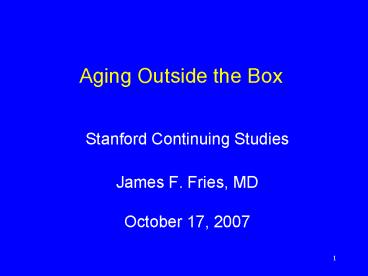Aging Outside the Box - PowerPoint PPT Presentation
1 / 18
Title:
Aging Outside the Box
Description:
Title: Vision and Opportunity Author: Immunology/Rheumatology Last modified by: Leslie Lindzey Created Date: 1/22/2005 12:05:39 AM Document presentation format – PowerPoint PPT presentation
Number of Views:61
Avg rating:3.0/5.0
Title: Aging Outside the Box
1
Aging Outside the Box
- Stanford Continuing Studies
- James F. Fries, MD
- October 17, 2007
2
Class Schedule
- General Themes
- October 17 Longevity
- October 24 Compression of Morbidity
- October 31 Declining Disability
- November l7 Aging and Health Policy
- December 5 Synthesis and Application
3
(No Transcript)
4
(No Transcript)
5
(No Transcript)
6
(No Transcript)
7
(No Transcript)
8
(No Transcript)
9
(No Transcript)
10
Some Paradoxes of Life Span and Life Expectancy
- Life expectancy increases more slowly at greater
ages. - Life expectancy requires that a life is lived
entirely in a single calendar year. - The term Life Span is often used in the sense
of Maximum Life Span Maximal Average Life
Expectancy is more appropriate for most issues. - Current trends in life expectancy cannot
continue. - Life expectancy for a given person is not a
constant The longer you have lived the greater
your estimated longevity.
11
Life Expectancy 1900 - 2000
Average of Years of Life Remaining Average of Years of Life Remaining Average of Years of Life Remaining Average of Years of Life Remaining Average of Years of Life Remaining Average of Years of Life Remaining Change in Years 1900-2000
Age 1900 1920 1940 1960 1980 2000 Change in Years 1900-2000
0 49.2 56.4 63.6 69.9 73.9 76.9 27.7
65 11.9 12.5 12.8 14.4 16.5 17.9 6.0
75 7.1 7.5 7.6 8.7 10.5 11.3 4.2
85 4.0 4.2 4.3 4.6 6.0 6.3 2.3
100 1.6 1.5 2.1 1.9 2.7 2.6 1.0
12
Life expectancy at birth and at 65 years of age
by sex United States, 1901-2002
Source Centers for Disease Control and
Prevention, National Center for Health
Statistics, National Vital Statistics System.
Chartbook on Trends in the Health of Americans /
Health, United States 2005
13
I. Projecting Future Life Expectancy U.S. Data
1900-2000
All Races, Both Sexes From Birth From Age 65
Life Expectancy (1900) 49.2 76.9
Life Expectancy (2000) 76.9 82.9
Increase (Years) 27.7 6.0
Increase/year (100 years) 0.277 0.06
Point (Year) of Paradox 84.6 84.6 (2028)
Source Health, United States, 2006
14
II. Projecting Future Life Expectancy U.S. Data
1980-2003
All Races, Both Sexes From Birth From Age 65
Life Expectancy (1980) 73.7 81.4
Current Life Expectancy (2003) 77.5 83.4
Increase (Years) 3.8 2.0
Increase/year (23 years) 0.165 0.087
Point (year) of Paradox 90.0 90.0 (2079)
Source Health, United States, 2006
15
III. Projecting Future Life Expectancy U.S. Data
1980-2003
White Females Only From Birth From Age 65
Life Expectancy (1980) 78.1 83.4
Current Life Expectancy (2003) 80.5 84.8
Increase (Years) 2.4 1.4
Increase/year (23 years) 0.104 0.061
Point (year) of Paradox 90.9 90.9 (2103)
Source Health, United States, 2006
16
CLUES AND CONJECTURES
- Genetics and/or Environment
- Super-Centenarians, Methuselah
- Loss of Organ Reserve and Homeostasis
- Soviet Georgia and Vilcabamba
- Out-Migration, In-Migration
- Declining Hormone Levels
- Elevated Growth Hormone
17
CONJECTURESAND CLUES
- The Fountain Myth
- Cryogenics
- Caloric Restriction
- Breeding
- Telomeres
- Genomics, Amyloid
- Anti-Oxidants, Notions and Potions
18
(No Transcript)

